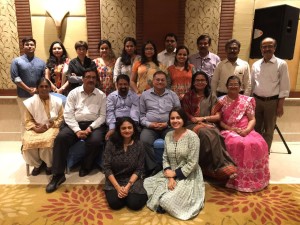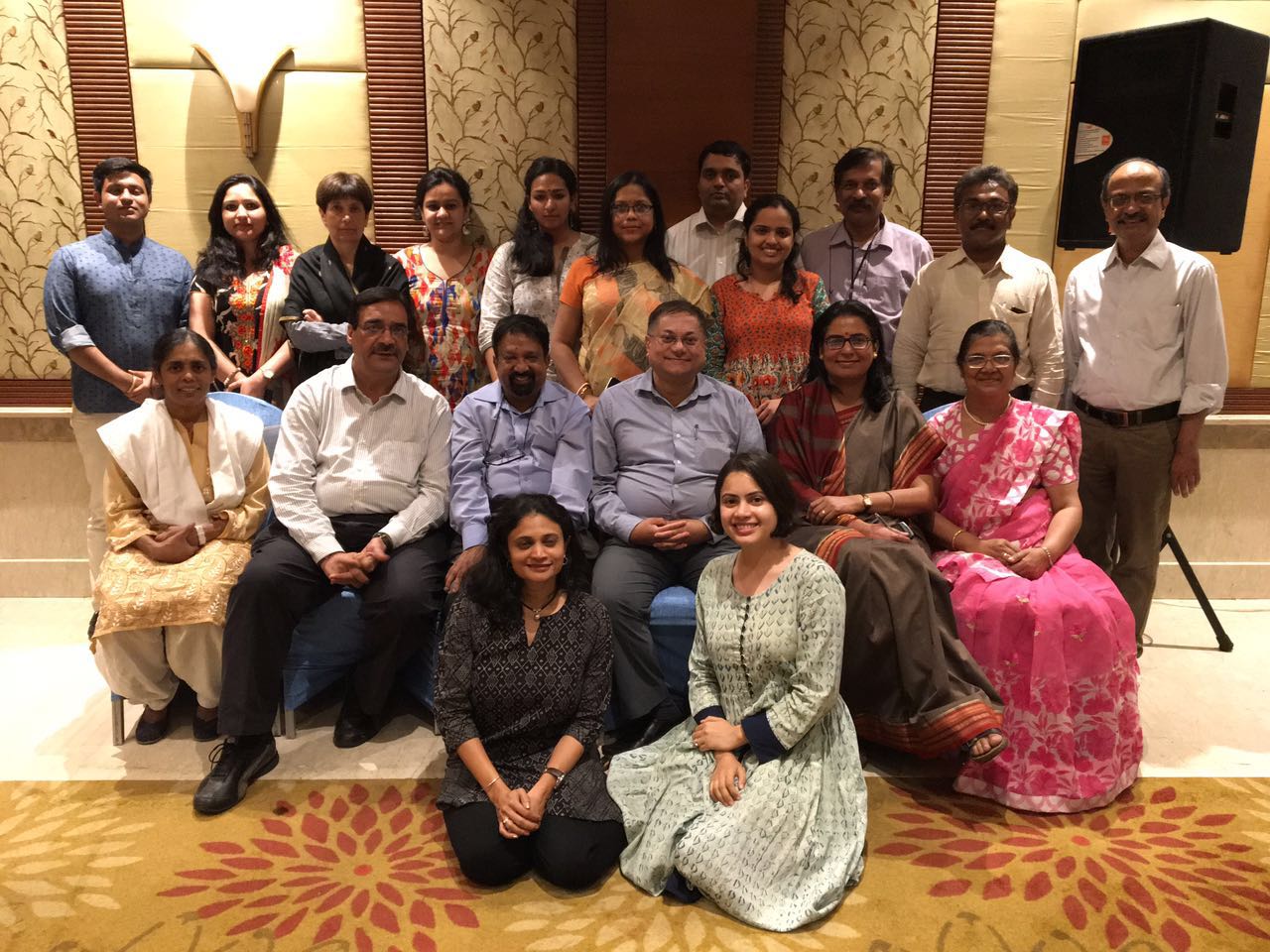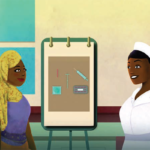Springboard India Learning Forum on Capacity Strengthening
Post by Sanjeeta Agnihotri, Programme Officer, Centre for Communication and Change India (CCC-I)
“If you focus on results, you will never change. If you focus on change, you will get results!”
-Jack Dixon
This quote shared by Dr. Ben Lozare at the Springboard India Learning Forum on April 5, sums up what we should aim to achieve through capacity strengthening.

Attendees of the India Learning Forum
Often times, as health professionals working in different locations of the world, we wonder if there are any ways of improving social and behavior change communication (SBCC) skills and practices – that of our colleagues and our own. Capacity strengthening in SBCC, despite being a vital component to success, is perhaps one of the most ignored parts of an intervention, initiative or a programme because we are not sure how to go about it.
To dig deeper into the issue of Capacity Strengthening for SBCC, Springboard India organized a learning form in partnership with the National Health Portal, a governmental online repository and directory of health related materials in India. The session was also broadcast as a webinar and joined by an active, world-wide audience in addition to the face to face participants at Hotel Suryaa, New Delhi.
The session’s interesting mix of speakers joined in from the United States, India and Israel.
Springboard India’s Steering Committee comprises of a mix of SBCC practitioner organizations such as PATH, J. Walter Thomson-Social, DFID, WHO-India, Indian Institute of Mass Communication and USAID. Participants were welcomed by Sanjeev Kumar, a Steering Committee Member, who highlighted the objectives of the session.
Lively as ever, Dr. Benjamin Lozare’s presentation on ‘Principles of SBCC Capacity Strengthening’ was the show stealer; His vast network of students were all out to listen to their favourite ‘SBCC Guru’. He emphasized on the importance of capacity building as the process of nurturing a system to achieve its function or purpose more effectively and efficiently in a sustainable way. Why capacity strengthening is challenging and what we can do, were the key aspects covered by his presentation.
This was followed by a presentation on a very useful framework on SBCC Capacity Strengthening, called the Ecosystem Framework, by Uttara Bharath Kumar, Director of Capacity Implementation for the Health Communication Capacity Collaborative (HC3). The concept of an ‘Ecosystem’ i.e. the capacity can be assessed and strengthened at different levels- individual, organization and the system (which is like the connective tissue holding together the SBCC players). The Ecosystem model reflects the systematic assessment, design and implementation of customized and strategic capacity strengthening. While arising from the work of HC3, it is a model that can be used by any project seeking to strengthen SBCC capacity at the local, regional or global level. Various driving theories (Experiential theory, Institutional theory and Complexity theory) of the Ecosystem model were also discussed. Overall it was an enriching presentation which brought to light the importance of capacity at every level.
Dr. Sarbadhikari from National Health Portal, presented his experience in ‘SBCC Capacity Strengthening from India’. His presentation focused on the need of, ‘Virtual Capacity Strengthening Resources for India’. The challenges to capacity strengthening in India such as: large population size, numerous languages, physically remote locations and connectivity in dark regions, were discussed. Tools such as National Health Portal, available both in the website and mobile application format are crucial for capacity building in India, given the challenges mentioned above. Their unique feature was language adaptability (the website is currently available in six different languages) and information helpline for no-internet regions to help empower state and district level health workers. Leading and managing an important online tool in India, Dr. Sarbadhikari feels that for the future, empowering Digital India through a responsive capacity-building plan is intrinsic to the country’s progress.
Susan Liebtag joined the session from Israel. She presented the various tools, online courses and resources available and developed as part of USAID’s Health Communication Capacity Collaborative such as:
Leibtag, the Health COMpass curator, took the audiences through the step-by-step process of joining and using online tools as well as online courses. How to best learn from these courses in order to fill in existing gaps in SBCC was explained in great detail. Given the diverse nature of a country like India, online tools and resources play a vital role in filling the gaps and building capacity of people working at the grass roots. Not only that, they also provide an opportunity to share one’s own experience from the field and program examples with a global or country based audience.
The participants, especially those engaged in capacity building and training of state level and regional SBCC professionals, were appreciative of research primers) and implementation kits.
Springboard for Health Communication, an online network of SBCC practitioners, was also presented to the participants. The registration process, key features of the online platform and its importance as an online social network for the health communication community, were discussed. The very spirit of Springboard, that is connecting, engaging and sharing, was evident throughout the session. Some were veterans in the sphere of SBCC, while for others SBCC was a completely new subject. Since capacity strengthening is not a ‘one size fits all’ concept, participants had their own take away.
The session was wrapped up by Sushmit Malaviya, Communications Officer, PATH and Springboard Steering Committee Member. On behalf of the participants she reviewed the objectives of the session (which she said had been amply met) and how she felt so much less confused now about capacity strengthening.
Springboard India’s first learning forum’s goal was, as Dr. Ben Lozare says, “not to persuade but to simply stir the glass” of Capacity Strengthening, it’s importance and the tools available to the SBCC community in this regard.
The question and answer session was lively and engaging; presenters provided answers below to questions that were posed but went unanswered due to time constraints.
What are the tools available for assessing individual level SBCC skills?
Answer: FHI 360 has a great tool for assessing individual-level SBCC. There are a number of other tools for assessing organizational or other factors, in addition to individual. Some of them include:
SBCC Mapping Tool, the PROGRES_SBCC tool (up online soon), C-Change’s suite of capacity assessment tools, and a BCC and KM assessment tool. The Bangladesh eToolkit for SBCC Program Managers and Planner also has a great list of tools for assessing capacity.
Any plans for regional sharing conferences?
Answer: Springboard India has a few more exciting webinars planned. Stay tuned! There will also be a regional Leadership in Strategic Health Communication Workshop (LSHC) in Kathmandu, Nepal (September 12 – 22, 2016). More information will be posted about that very soon.
How often should the capacity building should happen? is it project based that an organization has to do?
Answer: Capacity strengthening plans should be based on needs identified during some sort of assessment process, so the frequency will vary. HC3 likes to look at capacity strengthening holistically since real capacity is built over time and not with a single event like a training. It is helpful to think about what can be done before an event to prepare for learning, and what can be done after to extend learning. Capacity strengthening truly is a process, and it requires preparation, action, reflection, and application to be effective. Ultimately, we have the goal of having organizations and individuals own the learning process so that capacity strengthening is not externally imposed. We recognize that there are often funding restrictions, so it has to be project-based, but the aim should be to spark interest and learning so that capacity strengthening can continue even in the absence of a project that has the mandate to build capacity. This can be one area where strengthening SBCC systems can have an impact. When there are effective systems in place that nurture good SBCC, organizations and individuals are better able to own their capacity strengthening.
Since individuals are found within organizations, would it be right to say that there might be an overlap in the capacity needs?
Answer: There may be some overlap, yes. But we would say that the organization is mainly focused on putting in place systems and processes, and creating an enabling environment for individuals to gain and use SBCC skills and knowledge. The organization needs to ensure it is financially, institutionally, and programmatically sustainable so that the staff can develop and implement effective SBCC programs. For example, an organization may not be programmatically strong in developing SBCC materials. In a sense, there is overlap, because the organization and the individuals need to be involved in ensuring there is materials development capacity. However, the organizational capacity would be in setting up systems and processes like guidelines for creating materials, processes for materials approval, hiring the right people, providing opportunities for mentoring or coaching, or setting up field trips. The individuals would be the ones gaining the skills and knowledge, practicing, and applying that knowledge.
It is critical to examine and unpack capacity development and ‘systems strengthening’ approaches in C4D … it’s something that we have been looking at UNICEF … can you speak to it?
Answer: The systems strengthening is really the connection and coordination piece. In order for SBCC to be done well in a given context, various actors must coordinate. Some activities to strengthen SBCC systems include: organizing technical working groups or communities of practice, developing national strategies, creating national guidelines for SBCC (message development, materials, evaluation), developing national repositories for strategies and materials, creating harmonized messages for all partners, setting up exchange or field trip opportunities, supporting SBCC as a profession, ensuring sufficient funding for SBCC, establishing forums for learning and exchange, formulating SBCC policies and frameworks, or setting up national centers of excellence. Essentially, the systems should help to create a supportive environment so that organizations and individuals can design, implement, and evaluate SBCC programs.
How we can add any materials to The Health COMpass?
Answer: We welcome you to add materials to the Health COMpass! To do so, you need to register on the site. Once on the site, you can click on the Contribute tab to add your materials. You decide whether your resource is a Capacity Strengthening Tool or a Project Example and click on that button. The two criteria for having materials published on the Health COMpass is that they were developed using a strategic communication process, and that they were shown to be effective. Once you submit your materials, they will go through an approval process, and you will hear back once it is published.








Leave a Reply
Want to join the discussion?Feel free to contribute!